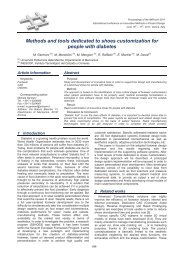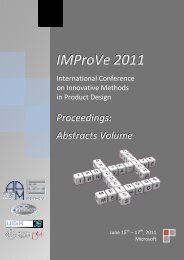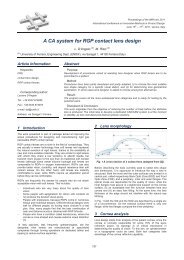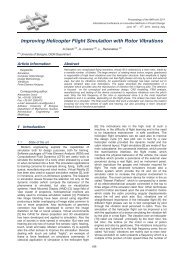IMProVe 2011 - Proceedings
IMProVe 2011 - Proceedings
IMProVe 2011 - Proceedings
Create successful ePaper yourself
Turn your PDF publications into a flip-book with our unique Google optimized e-Paper software.
Simulation and Experimental Approaches<br />
An objective evaluation method is proposed to assess the accuracy of 3D simulation by<br />
comparing the quality of 3D virtual simulation results. Generally speaking, 3D clothing<br />
simulation is accurate because 18 out of the 20 tested fabrics have statistically similar<br />
results of 3D simulation and the real sample. The simulated results of the two fabrics are<br />
different from the real sample, particularly in the hip areas. Further study is thus required.<br />
With the range of validity identified, guidelines can be provided to the fashion industry for<br />
the use of 3D simulation system in design and fit evaluation.<br />
Keywords: 3D virtual simulation, Garment fit evaluation, Fabric drape.<br />
Corresponding Author: P.Y. Mok<br />
Tel.:+852 2766 4442<br />
Fax.: +852 2773 1432<br />
e-mail: tracy.mok@inet.polyu.edu.hk<br />
Address: Institute of Textiles and Clothing, The Hong Kong Polytechnic University, Hunghom, Hong<br />
Kong.<br />
Simulating airport operations in a synthetic environment<br />
S. Bagassi (a), D. Francia (b), F. Persiani (a)<br />
(a) Second Faculty of Engineering, University of Bologna<br />
(b) Faculty of Engineering, University of Bologna<br />
Abstract:<br />
Current research on ATM (Air Traffic Management) is progressively focusing on the “green<br />
operations” concept. The European Commission as well as foreign institutions has<br />
identified Air Traffic as one of the sectors in which a “green” policy could be successfully<br />
implemented. Starting from the ACARE strategic research agenda, published in 2002,<br />
many EU funded projects have been launched aiming at a dramatic reduction of noise and<br />
pollution produced by Air Transportation System.<br />
Airport operations strongly affect the pollution and noise produced by an aircraft during<br />
the whole mission impacting on the environment and people living near airports. On the<br />
other hand, airport area and more generally the Terminal Aerodrome Zone is the<br />
bottleneck of Air Traffic System. The maximum capacity of Air Space is limited by the<br />
capacity of the airports.<br />
Therefore, the optimization of such operations is recognized as a challenge that aims at<br />
finding the best trade-off solution in order to maximize the airport capacity and minimize<br />
both pollution and noise.<br />
Modelling and simulation are the most powerful tools to study such an optimization<br />
problem. To help the evaluation of the model performances, a synthetic environment able<br />
to faithfully represent the airport area and its players (aircraft, helicopters, ground<br />
vehicles, etc.) is presented in this paper as an analysis tool.<br />
An experimental scenario that simulates Rome Fiumicino airport has been developed. In it<br />
aircraft are modelled as single material points and they are moved by an external<br />
June 15 th – 17 th , <strong>2011</strong>, Venice, Italy<br />
84<br />
<strong>IMProVe</strong> <strong>2011</strong> - <strong>Proceedings</strong>










